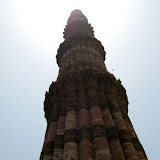JAIPUR (Pink City)
Jaipur is the first planned city of India, located in the semi-desert lands of Rajasthan. The city which once had been the capital of the royalty now is the capital city of Rajasthan. The very structure of Jaipur resembles the taste of the Rajputs and the Royal families. At present, Jaipur is a major business centre with all requisites of a metropolitan city. For more pic CLICK HERE
The city is remarkable among pre-modern Indian cities for the width and regularity of its streets which are laid out into six sectors separated by broad streets 111 ft (34 m) wide. The urban quarters are further divided by networks of gridded streets. Five quarters wrap around the east, south, and west sides of a central palace quarter, with a sixth quarter immediately to the east. The Palace quarter encloses a sprawling palace complex, (Hawa Mahal), formal gardens, and a small lake. Nahargarh Fort, which was the residence of the King Sawai Jai Singh II, crowns the hill in the northwest corner of the old city. The observatory, Jantar Mantar, is one of the World Heritage Sites.[1] Jaipur is a popular tourist destination in Rajasthan and India.
Jaipur was founded in 1727 by Maharaja Sawai Jai Singh II who ruled from 1699–1744 and initially his capital was Amber, which lies at a distance of 11 km from Jaipur. He felt the need of shifting his capital city with the increase in population and growing scarcity of water. The King consulted several books on architecture and architects before making the layout of Jaipur. Finally under the architectural guidance of Vidyadar Bhattacharya, (initially an accounts-clerk in the Amber treasury and later promoted to the office of Chief Architect by the King) Jaipur came into existence on the classical basis of principles of Vastu Shastra and similar classical treatise.
After waging several battles with the Marathas, Maharaja Sawai Jai Singh II was keen on the security aspect of the city. Being a lover of Astronomy,Mathematics and Astrophysics, Jai Singh sought advice from Vidyadhar Bhattacharya, a Brahmin scholar of Bengal, to aid him to design many other buildings including the Royal Palace in the center of the city.
The construction of the city started in 1727. It took around 4 years to complete the major palaces, roads and square. The city was built following the principles of Shilpa Shastra, the science of Indian Architecture. The city was divided into nine blocks, of which two consist the state buildings and palaces, with the remaining seven allotted to the public. Huge fortification walls were built along with seven strong gates.
For the time, architecture of the town was very advanced and certainly the best in Indian subcontinent. In 1853, when the Prince of Wales visited Jaipur, the whole city was painted pink to welcome him during the regime of Sawai Ram Singh. Today, avenues remain painted in pink, provide a distinctive appearance to the city.[2] In the 19th century the city grew rapidly; by 1900 it had a population of 160,000. The city's wide boulevards were paved and lit.
The city had several hospitals. Its chief industries were of metals and marble, fostered by a school of art founded in 1868. The city also had three colleges, including a Sanskrit college (1865) and a girls' school (1867) initiated under the reign of the enigmatic Maharaja Sawai Ram Singh II. There was also a wealthy and enterprising community of native bankers, particularly the Jain,Marwaris and the administrators Kayastha. Maharaja Sawai Bhawani Singh Bahadur is the current Maharaja of Jaipur.
Jaipur was founded in 1727 by Maharaja Sawai Jai Singh II who ruled from 1699–1744 and initially his capital was Amber, which lies at a distance of 11 km from Jaipur. He felt the need of shifting his capital city with the increase in population and growing scarcity of water. The King consulted several books on architecture and architects before making the layout of Jaipur. Finally under the architectural guidance of Vidyadar Bhattacharya, (initially an accounts-clerk in the Amber treasury and later promoted to the office of Chief Architect by the King) Jaipur came into existence on the classical basis of principles of Vastu Shastra and similar classical treatise.
After waging several battles with the Marathas, Maharaja Sawai Jai Singh II was keen on the security aspect of the city. Being a lover of Astronomy,Mathematics and Astrophysics, Jai Singh sought advice from Vidyadhar Bhattacharya, a Brahmin scholar of Bengal, to aid him to design many other buildings including the Royal Palace in the center of the city.
The construction of the city started in 1727. It took around 4 years to complete the major palaces, roads and square. The city was built following the principles of Shilpa Shastra, the science of Indian Architecture. The city was divided into nine blocks, of which two consist the state buildings and palaces, with the remaining seven allotted to the public. Huge fortification walls were built along with seven strong gates.
For the time, architecture of the town was very advanced and certainly the best in Indian subcontinent. In 1853, when the Prince of Wales visited Jaipur, the whole city was painted pink to welcome him during the regime of Sawai Ram Singh. Today, avenues remain painted in pink, provide a distinctive appearance to the city.[2] In the 19th century the city grew rapidly; by 1900 it had a population of 160,000. The city's wide boulevards were paved and lit.
The city had several hospitals. Its chief industries were of metals and marble, fostered by a school of art founded in 1868. The city also had three colleges, including a Sanskrit college (1865) and a girls' school (1867) initiated under the reign of the enigmatic Maharaja Sawai Ram Singh II. There was also a wealthy and enterprising community of native bankers, particularly the Jain,Marwaris and the administrators Kayastha. Maharaja Sawai Bhawani Singh Bahadur is the current Maharaja of Jaipur.





Comments